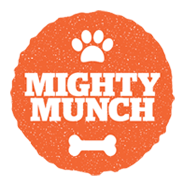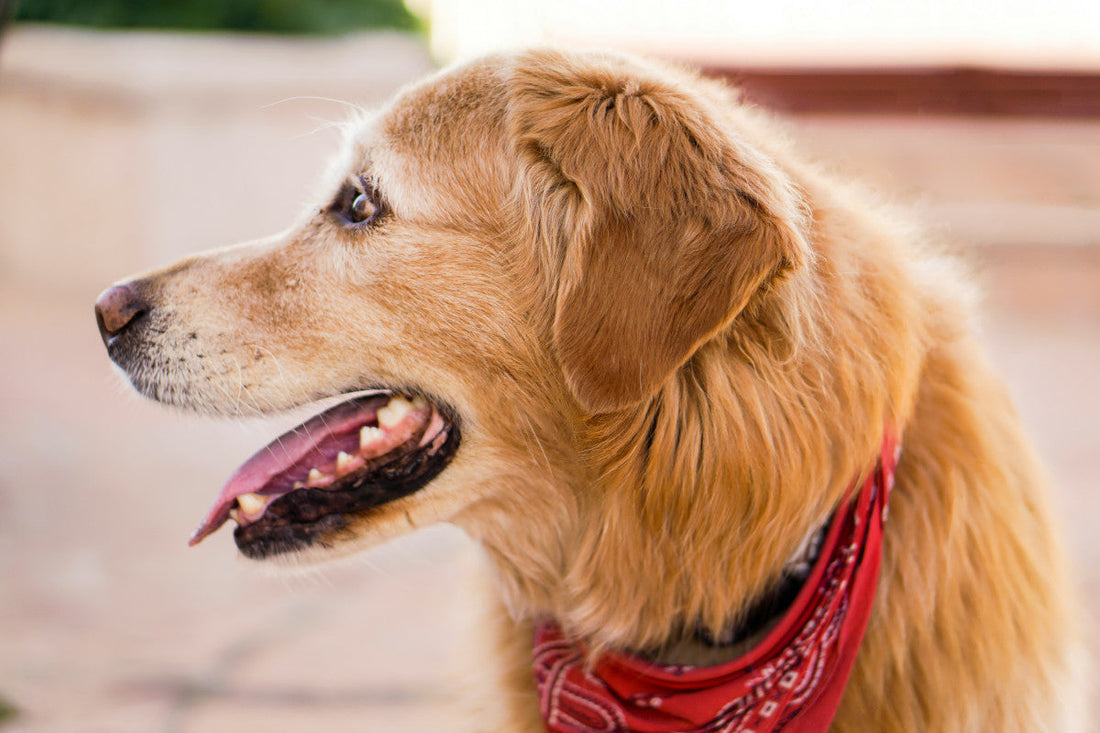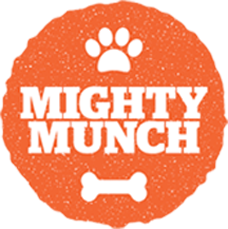Many dogs don’t get proper dental care and have red and inflamed gums to show for it. But dog gum health is very important for your pet’s well-being and quality of life. Left untreated, canine gum disease causes gum and mouth pain, loose teeth, and even liver, kidney, and heart issues.
We’ve written this guide to help concerned pet parents keep their dog’s gums healthy. We’ll show you how to distinguish between healthy dog gums vs unhealthy gums. And you’ll learn how to improve dog gum health and how to clean dog teeth naturally.
Our dog dental chews are the top choice for dog owners who want the best canine dental health aids for their dog. Mighty Munch makes all its dental sticks for dogs in a human-grade facility. There are no grains or artificial flavourings, and dogs love the taste.
Read on to find out more about how to improve dog gum health and your dog’s quality of life with Mighty Munch.
“Dougal & Digby love them! Natural ingredients & probiotics in one! Results speak for themselves, fresh breath, clean, white, healthy teeth & gums!” - Daniel
“These are really great, we have seen a definite improvement in the health of both gums and teeth! She loves them taste wise as well, and this dog is the fussiest dog !!!” - Kiara
“Awesome product, my gorgeous but pain in the arse Staffy lol loves them, his teeth and gums are very healthy. Best product on the market. We receive auto delivery very 8 weeks. Very happy with this product, thank you Mighty Munch.” - Sophie
Why Dog Gum Health Matters
Over 80 percent of dogs over the age of 3 have some form of dental disease. Dental disease starts in the gums, so maintaining good dog gum health is very important. Here are some of the consequences of untreated dog gum disease.
Healthy Gums Prevent Painful Dental Disease
Healthy dog gums not only hold your dog’s teeth in place. They also prevent bacteria from infecting their teeth and bones. Gum cells are tightly packed so bacteria have difficulty passing between them. And helpful bacteria that reside atop the gums keep out harmful intruders.
Your dog’s gums grow red and inflamed when they are infected by harmful bacteria. These germs can spread to bone and mouth tissue if left untreated. Veterinary dentists call the initial infection gingivitis, and when it spreads to bone and mouth they call it peritonitis.
Poor Gum Health Can Lead to Tooth Loss and Infection
As gum disease progresses through the next dog periodontal disease stages, your dog’s teeth become loose. The gums recede, exposing sensitive tooth roots. The teeth may wriggle in their mouths and even fall out. Veterinary tooth implants and oral surgery are very painful for dogs and very expensive for you.
Unhealthy Gums Can Harm the Heart, Kidneys, and Liver
When the bacteria that cause gum disease get into the bloodstream, they’re transported throughout your dog’s body. They can then set up house in other organs and cause serious canine health complications.
Bacteria can cause endocarditis, an inflammation of the heart membrane, if they reach your dog’s heart. Dogs with endocarditis start losing weight and become lethargic. This can lead to heart murmurs, fever, and even strokes and heart failure.
Oral bacteria in your dog’s bloodstream can also infect the kidneys. Your dog may be unusually thirsty and you may notice blood in their urine. A serious kidney infection can leave your dog with chronic kidney disease.
If oral bacteria infects your dog's liver it can lead to hepatitis or cirrhosis. Watch out for signs of abdominal pain and yellowish gums and eyes.
All these conditions are serious and can be fatal. Fortunately, there are many ways to improve dog gum health. But how do you distinguish between healthy dog gums vs unhealthy gums, and what do healthy dog gums look like?
Healthy Dog Gums vs Unhealthy: What Do Healthy Dog Gums Look Like?
Here are some signs that will help you distinguish between healthy dog gums vs unhealthy dog mouths.
Colour
Healthy dog gums are typically salmon to fairy floss pink in colour. Some dog breeds, like Chows or Australian Shepherds, may have black or dark brown gums. Gum issues can cause the gums to change to several different colours.
Gingivitis causes your dog’s infected gums to become red. Pale pink or white gums can be a sign of internal bleeding or anemia. Dogs with respiratory or cardiovascular issues will often have blue or purplish gums, and liver or kidney issues can turn your dog’s gums yellow.
Texture and Moisture
Healthy dog gums are firm, smooth, moist, and slightly slippery when you touch them. If you press on your dog’s gums, the pressure point should become white and then quickly return to pink within one or two seconds.
On the other hand, your dog may have circulatory issues or be dehydrated if the pressure point remains pale for more than a few seconds. Sticky or dry gums are another common sign of dog dehydration that could point to poor gum health.
Odour and Bleeding
Your dog’s breath is never going to smell like a rose garden. But especially foul dog breath can be a sign of septic gums. Bleeding along the gumline after eating or brushing means that your dog has gingivitis.
When to Get a Professional Assessment
Consult with your vet immediately if your dog’s gum colour changes, as it could be a sign of serious underlying health issues. Your dog needs veterinary intervention and dental cleaning immediately if you notice that their teeth are loose or if you see heavy tartar build-up around their gumline.
How to Improve Dog Gum Health
Gum infections should be treated immediately. Fortunately, there are many ways to treat or avoid gum disease in dogs. Here are some pointers on how to improve dog gum health to protect your pet’s oral hygiene.
Start With a Daily Oral Care Routine
Daily brushing is a good choice for how to improve dog gum health. But your dog may not agree. Many dogs dislike toothbrushes and every brushing can become a struggle that leaves both of you exhausted.
But even dogs who hate brushing love chewing on things. In the wild wolves use raw bones to rid their teeth of tartar. Give your dog a daily dental dog chew for a less messy alternative.
The chew’s rough surface helps remove tartar from dog teeth. And many of the best dental chews for dogs add additional ingredients to help keep your dog’s gums and mouth in peak condition. But we add a special ingredient that stops gum infections before they start.
Use Our Probiotic Dental Chew
You may know that probiotic dog supplements can help maintain your dog’s gut microbiome and help them fight allergies and inflammation. But did you know that dogs also have a microbiome in their mouth?
Our Dental Sticks for Dogs contain over 1 billion NFCU each of two potent probiotics, Lactobacillus reuteri and Streptococcus thermophilus. L. reuteri produces antimicrobial substances that kill harmful germs and S. thermophilus produces bacteria-killing lactic acid.
Both these beneficial bacteria also work to prevent gum disease by crowding out disease-causing bacteria. They form a biofilm around your dog’s teeth and gums that stops harmful germs from finding a home in your dog’s mouth.
Our dental chews are a safe, natural and enjoyable way to keep your dog’s teeth clean. Add Mighty Munch to your dog’s dental cleaning regimen today!
“My dog loves the Mighty Munch dental sticks, at her recent vet visit they were very impressed with how clean her teeth are and how healthy her gums are, Luna is seven years old. The vet said to keep doing what I'm doing as she is benefitting from the routine” - Merron
“Very happy with the dental sticks. Finally got a hard variety instead of the useless Pedigree or similar brands which are just like biscuits and gone in about 10 seconds with 2 of our dogs. Many thanks.” - Wendy
“My little red toy poodle is a fussy eater and has a sensitive tummy as well. On opening the packet for the first time, she couldn't wait to grab a dental stick. She is devouring it!!! I am hoping this continues. Thank you from my little red girl.” - Bonnie
Incorporate Dental Water Additives or Oral Sprays
Dental water additives or oral sprays are great for dogs who don’t like brushing. You can add them to your dog’s water bowl or spray them in their mouths. It’s less traumatic and helps eliminate harmful bacteria that cause gum disease.
Our pet dental care water additive is a great dog plaque remover and natural way to improve your dog’s oral health. It uses aloe leaf extract to soothe and heal inflamed gums, with spearmint and peppermint oil to kill harmful bacteria and freshen your dog’s breath.
Feed a Diet That Supports Oral Hygiene
Crunchy snacks like apple slices and carrot sticks are a natural way to clean your dog’s teeth. They remove tartar and food debris as your dog chews, and also provide important vitamins and minerals.
Ask about a prescription oral health care dog diet if your dog has recurring dental issues. These diets are formulated by veterinarians to keep your dog’s teeth and mouth cleaner and reduce the risk of gingivitis and gum issues.
Regular Vet Checkups and Professional Cleanings
Some pet parents try to avoid the high dog teeth cleaning cost by skipping vet visits. But good canine dental health is important, and you need to see a veterinarian for a professional cleaning if your dog is showing signs of gum disease.
While your dog may need tooth cleanings occasionally, you can stretch out the time between them with regular home dental care. Mighty Munch’s dental sticks for dogs can be an important part of that regimen.
Our dental sticks help canine oral health in multiple ways. Their shape and texture help scrape away tartar and plaque to keep it from building up. As your dog chews, saliva washes these particles away. And probiotic bacteria crowd out and kill harmful bacteria on your dog’s gums.
If your dog has a history of mouth issues, Mighty Munch’s pet dental care water additive can be a good supplement to our dog chews. It helps freshen breath, soothe inflamed gums, and promote gum and mouth health.
Don’t wait until your dog suffers from inflamed gums or other oral diseases. Mighty Munch takes care of oral canine diseases before they start. Count on Mighty Munch for all your dog’s oral health care needs.
Bringing Our Comparison of Healthy Dog Gums vs Unhealthy to a Close
And that wraps up our article on healthy dog gums. You no longer have to ask, what do healthy gums look like? And you know several ways to keep your dog’s gums healthy. You can save your dog the suffering of oral disease and save yourself money on expensive vet visits.
Untreated gum disease can escalate into serious oral conditions or even chronic heart and kidney issues. Don’t neglect your dog’s oral health; keep their mouths clean and their gums healthy with Mighty Munch.


